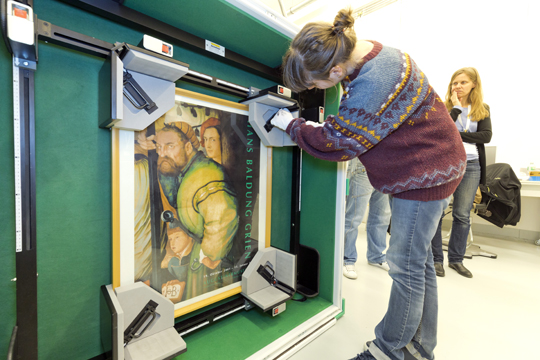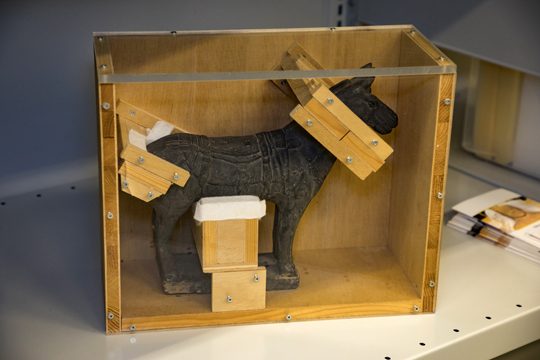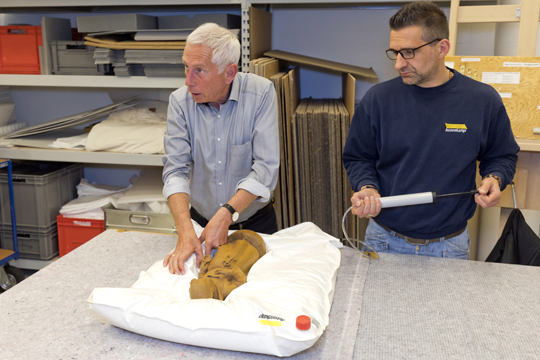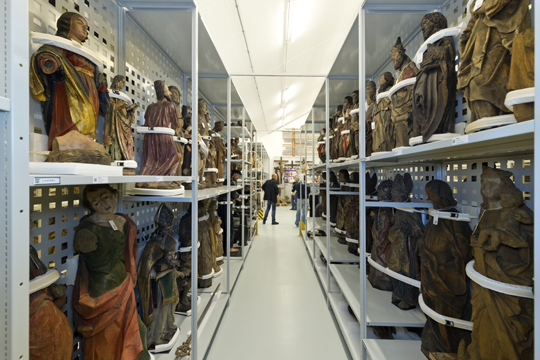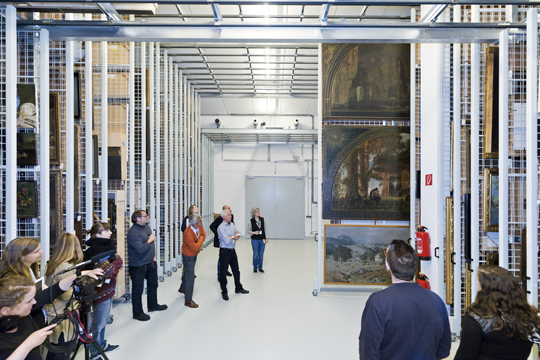Artworks Travel the World
Freiburg, May 02, 2017
A conference entitled "From Me to You, Collecting – Documenting – Loaning" or („Von mir zu Dir. Sammeln – Dokumentieren – Leihen“) was held at the University of Freiburg at the end of April 2017. The event is the annual working conference of Deutscher Museumsbund (DMB) Collection Management Working Group's Documentation Specialist Group. The organizer and local partner this year is „MuseOn/Weiterbildung & Netzwerk“ (MuseOn/Continuing Education & Network), which is directed by Dr. Christian Wacker. „MuseOn" is a university institution that offers programs for continuing, academic education of museum personnel. Eva Opitz spoke with Christian Wacker about the challenges of organizing special exhibitions.
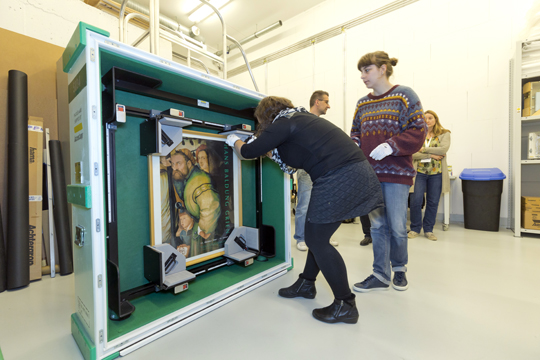
At a continuing education event held by „MuseOn" course participants learn to pack artworks securely for transportation at the Central Art Warehouse in Freiburg. Photos: Jürgen Gocke
Mr. Wacker, why did the DMB Working Group choose Freiburg as the venue for the conference?
Christian Wacker: The deciding factors were the diversity of the academic modules in our program as well as the many interfaces with the curatorial activities of a university with a long, rich tradition. So this year, rather than gathering in a museum, collection curators from all over Germany will come to the University of Freiburg.
What is the focus of the conference?
The spotlight will be on loans between collections. This has increased markedly in recent years together with the number of special exhibitions. The key works of some museums are continuously on loan. Museums' readiness to help each other has also grown. The slogan for this type of cooperation could be: "I'll give you my Picasso if you give me your Van Gogh." That means a great deal of work for the museum, but it also clearly increases visitor numbers, and that is the criteria for measuring museum success.
What are the most important steps when a museum is planning a special exhibition?
The first step is for the borrower to make inquires at the museum of their choice. If the museum checks the application and agrees to the loan, then transportation and insurance are the next issues that come up. The insurance value is based on the value of the image and the risks of transporting it. If the pieces have to be transferred along the way, then the costs immediately go up. Only a few, very specialized, shipping firms are suitable for transporting valuable objects. The entire procedure drives the costs up. Take, for example, a painting by the Dutch artist Vermeer. A borrower could end up paying a six-figure sum to move that artwork.
Is the danger that the work could be stolen along the way among the risks?
No. That's quite clear. The owner is entitled to maximum security. Up to now, I don't know of any cases in which something was stolen or lost during transport. What can, however, happen is that a crated artwork ends up being left out in 50°C heat for two or three hours as it's being transferred at the airport. That happens. It doesn't matter if what's in the crate are bananas or a Picasso. The transportation crates are climate controlled and fitted out with all the latest refinements. By treating the painting with the utmost care, which the loaner can certainly demand, it would also be suspended in a transportation frame to cushion it from possible bumps. The whole issue of transporting art has become a science in and of it self.

Loans of works between collections have increased along with the number of special exhibitions, reports Christian Wacker. Photo: Jürgen Gocke
Are there images and other collection pieces that will never be seen in a special exhibition?
Yes, one of them is the Mona Lisa in the Louvre. Because of the sheer enormity of the number of requests and the risks of moving it are so great, the responsible curators have decided that the famous image will not go out on loan. Furthermore, because it is so apparent that a work of such great delicacy has been created and that it could be damaged even if every precaution is taken, it remains in its usual place in the museum.
Is loaning out works of art limited only to large, well-known collections?
No, absolutely not. Particularly the smaller, regional collections have pieces that are in demand. And exchanges are good for these museums. That's how a whistle from the 1954 Football World Cup in the collection of the Basel Sportmuseum ended up being sent all the way to Manchester. Of course a tractor trailer wasn't required. One of the curators simply packed it and brought it to England personally.
How do managing curators of special exhibitions find out which works could be of interest to them?
Earlier, all artworks were recorded in card catalogs. Digital registration of pieces on display and in warehouses have changed all that radically. The curators can rapidly get an overview that way. It shortens research times and enhances the quality of the exhibition.
For more information on the conference (in German)
museOn | advanced education & network
Some impressions of the event:

